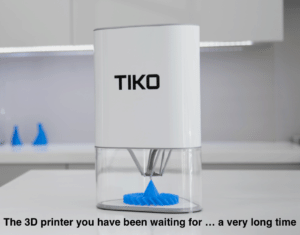“Tiko 3D: Another crowdfunding fail, as backers money goes down the drain.”
Tiko 3D is the second most-funded 3D printer on Kickstarter ever —the first being M3D who launched the Micro consumer 3D printer back in 2014. M3D raised $3.4 million on Kickstarter from over 11,800 backers. M3D is operating today and appears to be doing well in the highly  competitive 3D printing market. Tiko 3D unfortunately “overpromised and undelivered” by shipping very few 3D printers. Last week, Tiko 3D put itself on “standby” as the company had run out of money.
competitive 3D printing market. Tiko 3D unfortunately “overpromised and undelivered” by shipping very few 3D printers. Last week, Tiko 3D put itself on “standby” as the company had run out of money.
Michael Armani, the CEO and co-founder of M3D, believes the trend of failed tech companies on Kickstarter is a “troubling” trend for the rewards crowdfunding sector. Crowdfund Insider recently reached out to Armani for his unique perspective on the failed Tiko 3D campaign and what could have been done better.
Crowdfund Insider: M3D successfully raised $3.4M on Kickstarter for a 3D Printer. Did you deliver all of your printers? Were there any hurdles or issues along the way?
Michael Armani: Yes, we delivered the bulks of these rewards a long time ago (amazingly, there is a very long tail of few backers still following up, but we are actively closing them). Like any new business, there were huge issues that we faced at first, namely customer support and product quality. We realized how important these are to creating strong customer relationships, so we made them an immediate priority for the company—our quality has been much improved and customer service is headed towards becoming, in my view, legendary and a key differentiating value. We are all under one roof in Maryland and able to work closely across teams.
We focused on solving the biggest problems first by either reducing or outright eliminating them. One-by-one all the links fell into place for a working, sustainable business that we could improve gradually. In a sense, it was like triage. One of these challenges was to not over-perfect the design. It was the right decision to release the product when it was at about 90 percent ready for market, and to keep improving iteratively along the way with customer feedback—we included the thoughts from the community in our product’s ongoing development.
Crowdfund Insider: Did you outsource any or all of the campaign? Did you get help from a company like Dragon?
Michael Armani: No, we did pretty much everything ourselves, with some external support when it comes to marketing and public relations. We did talk to Dragon briefly but they wanted an exorbitant amount of money for us to receive some basic engineering advice—and if we couldn’t afford that with a $3.4M Kickstarter campaign, no one can.
 Crowdfund Insider: How is M3D doing today?
Crowdfund Insider: How is M3D doing today?
Michael Armani: We’re a leader in consumer 3D printing market with our 100+ filament choices and dedicated US-based support, and M3D’s mojo is doing extremely well today. Our management team has expanded to include many like-minds and is inspired to serve our company vision: M3D is an innovation company, and we innovate affordable, cool technologies and business processes. You can expect to see a pretty dramatic expansion of M3D’s product lines in 2017—not all of them will relate to 3D printing.
Crowdfund Insider: Have you raised additional capital from Angels/ VCs? If not are going to? Or perhaps use an investment crowdfunding platform?
Michael Armani: M3D is fundamentally driven by organic, 100 percent bootstrapped growth. We never took an investment, and right now we have no debt or loans. We’re not eager to attract the attention of investors. It’s a huge time burden to “court” them, and it can take up to a year to secure an investment, time that we can better spend boosting our organic sales growth. We’re in it for the long haul—the 5-10 year vision where 3D printers routinely print human organs, and make assembled products so good that it disrupts trade, manufacturing, and engineering as we know it today.
That said, we are open to strategic investors who want to help us develop these next-level technologies, like high-resolution color and bio print heads to advance the field of 3D printing—should they read this article you can let them know to reach us here.
Crowdfund Insider: Tiko 3D, the 2nd most funded 3D printer in Kickstarter history, experienced a dramatic collapse. Were there signs of problems at the beginning?
Michael Armani: Yes, we knew on day one that Tiko, Peachy, Xmachines, and a few others were destined for failure. For a business in North America, it’s not feasible to have a cost of goods that’s 65 percent of the sales price—that’s the rate a reseller like Newegg gets and that was a dead giveaway for us. A manufacturer needs to have margins well over four times to survive, maybe five times to thrive if they are doing production, marketing, sales and support.
Crowdfund Insider: Tiko 3D made multiple operational errors. What should they have done differently?
Michael Armani: Tiko needed to do a better job with formal, consistent and professional communication with their backers. We think trust is first and foremost—it’s critical—and they lost that somewhere along the way. Their cost of goods were unfeasible from the start, and it didn’t account for rejects, failures, rebuilds, warranty parts, etc. They also took pre-orders way too late into the campaign. It also seems clear they should have developed a more production ready prototype before launching their Kickstarter.
Crowdfund Insider: Can rewards-based platforms do a better job of helping hardware campaigns? Are backers partially to blame for viewing them as online stores?
Michael Armani: Because of this single key mistake of trying to offer too much value in order to capture market awareness, Kickstarter has become a sort of wild-west Ponzi scheme tech bubble, especially toxic for 3D printers, an industry that is in some ways still finding its footing among mainstream consumers. It is without a doubt, in my opinion, that a crowdfunding platform should be evaluating the technical feasibility, cost analysis and credibility of the creator before issuing a greenlight. A lot of the people that bring an innovative project to a platform like Kickstarter just get way too far in over their heads.
Crowdfund Insider: Any suggestions to backers of Tiko 3D?
Michael Armani: Tiko supporters, like all backers, are a curated fan base that supported a very specific product—they wanted an affordable and easy-to-use 3D printer with third-party compatibility, not just another 3D printer that may require some tinkering here and there. They saw something they believed in so strongly that they would risk their hard-earned money for a product that may never come, but would certainly take a year to develop. And these are mostly bargain hunters, they don’t have that much money to waste; “I got this for my son, now my wife and son are mad at me” is on its way to memedom. Unfortunately, we believe there is no practical solution to their problem at this stage, other than a strategic partnership. However, many still want a printer, and because our printer has similar characteristics and is in stock, we are offering Tiko backers (or backers of any crowdfunded campaign that went belly-up) a deep-discount price of when we launched the Micro 3D printer at $199 to support the industry. Learn more at www.printm3d.com/backer-rescue
Have a crowdfunding offering you'd like to share? Submit an offering for consideration using our Submit a Tip form and we may share it on our site!


